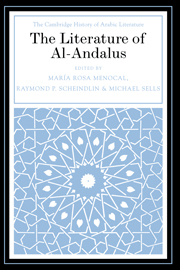Book contents
- Frontmatter
- 1 Visions of al-Andalus
- PART I THE SHAPES OF CULTURE
- PART II THE SHAPES OF LITERATURE
- PART III ANDALUSIANS
- 10 Ibn Ḥazm
- 11 Moses Ibn Ezra
- 12 Judah Halevi
- 13 Petrus Alfonsi
- 14 Ibn Quzmān
- 15 Ibn Zaydūn
- 16 Ibn Ṭufayl
- 17 Ibn ʿArabī
- 18 Ramon Llull
- 19 Ibn al-Khaṭīb
- PART IV TO SICILY
- PART V MARRIAGES AND EXILES
- PART VI TO AL-ANDALUS, WOULD SHE RETURN THE GREETING
- Index
- References
13 - Petrus Alfonsi
from PART III - ANDALUSIANS
Published online by Cambridge University Press: 28 May 2012
- Frontmatter
- 1 Visions of al-Andalus
- PART I THE SHAPES OF CULTURE
- PART II THE SHAPES OF LITERATURE
- PART III ANDALUSIANS
- 10 Ibn Ḥazm
- 11 Moses Ibn Ezra
- 12 Judah Halevi
- 13 Petrus Alfonsi
- 14 Ibn Quzmān
- 15 Ibn Zaydūn
- 16 Ibn Ṭufayl
- 17 Ibn ʿArabī
- 18 Ramon Llull
- 19 Ibn al-Khaṭīb
- PART IV TO SICILY
- PART V MARRIAGES AND EXILES
- PART VI TO AL-ANDALUS, WOULD SHE RETURN THE GREETING
- Index
- References
Summary
Petrus Alfonsi, an Andalusian Jew who converted to Christianity early in the twelfth century, was just one of the many scholars of his time who lived both in and between Jewish, Christian, and Islamic cultures and took upon themselves the task of acting as a bridge between these traditions. Alfonsi’s education in Arabic science, philosophy, and particularly astronomy–and his level of erudition was not particularly extraordinary given the standards in Islamic Spain–gave him something of great value to communicate to Christian Europe. He explains his project: “[I]t is proper that all those who have drunk of any philosophical nectar love each other, and that anyone who might have anything rare, precious, and useful which is unknown to others should impart it generously to others, so that in this way everyone’s knowledge may both grow and be extended in time” (Tolan 172–73). As a converso he sought to convince the Jews of their error in rejecting Jesus; as an Andalusian intellectual, he brought missionary zeal to the dissemination of Islamic and Jewish learning among the Christians of Europe.
Alfonsi lived in a period of great change. The latter half of the eleventh century heralded an enormous shift in the balance of power around the Mediterranean. Christian forces made significant advances both on the Iberian Peninsula, where the Islamic Taifa states were divided and weakened, and in Sicily, which in 1091 fell to the Normans. While these conquests diminished the political presence of Islam in Europe, perhaps paradoxically they also opened up Christian Europe to Arabic philosophical, scientific, medical, astronomical, and literary cultures. Not only had vast libraries like that of Toledo come into Christian hands, but the conquered population of Mozarabs, Andalusian Jews, and Mudejares produced a profound cultural impact: Mudejar architecture, thousands of Arabic loanwords, and new cultural forms such as the troubadour lyric – strongly suggestive of the Arabic and Hebrew strophic poetry (muwashshahs and zajals) born and popularized in al-Andalus.
- Type
- Chapter
- Information
- The Literature of Al-Andalus , pp. 282 - 291Publisher: Cambridge University PressPrint publication year: 2000
References
- 2
- Cited by

